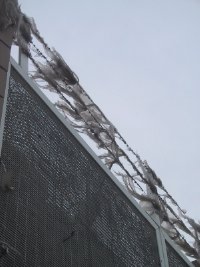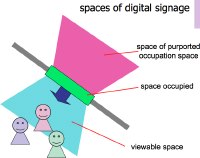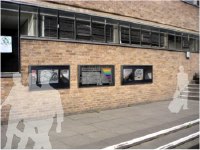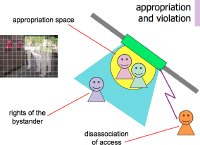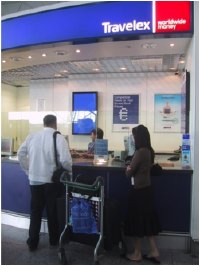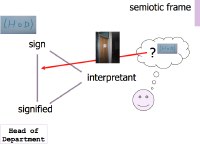reflections and orientations
These notes are based on two non-Place workshops at B&Q Warehouse in Edinburgh and at Stansted Airport. By its nature a reflection turns orientation back on itself and the danger of a reflection is that it is only meaningful for those who are standing to look in the mirror. Contrarily it is through this self-absorption in the mirror that we dress ourselves for others. non-Places seem unusually un-self-absorbed, given wholly to the other, and because of that have to be constructed far more reflectively than familiar Places.
place and Place
non-Places are not only locations on a map or areas of space, but they, like Places, are first places. To say "Stansted Airport” presupposes an understood social significance that suggests a Place-like quality.
To even refer to a particular non-Place as being a non-Place it needs to be intelligible and identifiable. These two properties, let's say, define a 'place' with a small 'p'.
Of course both place-ness and Place-ness are to some extent subjective for an individual or group. The "AirBrake People" warehouse and the church tower you can see from the M6 as you approach Forton services are both waymarks for me, and the fact I write about them means they are, for me, 'places', but not a Place, nor even a non-Place. However, for the people who work in the warehouse or who worship in the church, these are clearly Places.
Locations may become places through events of significance – the place where my car hit a piece of wood on the motorway; and become Places (or even non-Places) through commonly experienced or remembered events – Bosworth Field. But equally they may become Places through fiat – above the 49th parallel or Milton Keynes.
non-Places often also become Places. Most capital cities are on the sea coast, river mouths, other waterways or trade routes: the access, control or trading giving rise to communities. At Stansted the area around is developing because of the airport: hotels for travellers, but also a community for those for who work there.
teleology
The airport is full of signs: where to go for departures, arrivals, or the toilets, security notices, times of planes, places to eat. The sheer volume of signage is because of the number of strangers, people who have never been before, or come only rarely. If every air traveller were at the same airport day-by-day there would be less need for signs.
The significance of signage in non-Places is because they are places 'for' the outsiders, the strangers, not 'for' the insiders.
It is not that all signage is only for strangers: the words that say 'Marjoram', 'Thyme', 'Chilli' on otherwise identical ceramic spice jars. However, where there are strangers they need to be guided, helped and aided: the words that say 'tinkle here' on a distinctive ceramic doorplate.
Although the home has its own signage it is clear that the home is (normally) primarily 'for' the insiders, those who live there, whereas the airport or shop is 'for' the outsiders: travellers and customers.
In fact, these complex non-Places, whether shop, train station or airport, are supported by many insiders: people who work to make it work. At Stansted there were 168 different companies with many thousands of employees. Some have a public face at airport shops, security gates, or check-in, but many others work underground or behind the walls with their own offices, cafes and communities. Fly-on-the-wall documentaries often reveal the rich social fabric of these insider support communities that make the non-Places work for the outsiders.
For these insiders the non-Place is a place of work, a place of meeting with friends, a place with which they identify, a Place.
This outsider-orientedness is shared by other places such as holiday resorts, theatres, even hospitals. The same issues of signage apply but they are different. With the holiday resort or the theatre, the outsiders go to the Place in order to be in the Place. They are places of purpose whereas the airport is merely a place to go through in order to go to somewhere else. Likewise B&Q is somewhere you go to in order to make something somewhere else. Tourist and entertainment locations are places for the outsider but the outsider is there for the place. These Places of purpose are autotelic, they find their purpose within themselves, whereas the non-Place finds its meaning elsewhere.
semiotic orientation
Whilst the non-Place is for outsiders and the obvious mêlée of signage jostling for eye position speaks of the occasionality of the visitor, still there is also signage for the insider. On airport runways are numbers and letters, road-like markings on the tarmac, guiding lights and invisible radio beacons. These are signs not for the interpretation of the passengers (although ultimately for their safe transport). In fact, these signs themselves have an outsiderliness in that whilst many pilots fly the same routes day-in day-out the airport needs to be open to pilot outsiders, with the same issues of standardization and clarity across languages that apply to the terminal’s signage for passengers.
Even in the terminal there are signs for the insiders: barcodes on baggage, identification codes on displays and lettered stairways into the airport underbelly.
In spending a day at Stansted we went through doors that were not normally for outsiders. As a passenger we would have passed by and not noticed whole open stairways that somehow signposted themselves as ‘for’ the insider.
But not only the airport. At B&Q you look along the aisles accosted by orange and stupefied by the signage - special offers and information leaflets. On the shelves are labels: product and price, that’s all … or perhaps not, also sequences of numbers, you hardly notice, they are not for you to read. You look up, way above eye level and suddenly more signs for insiders: each shelf is numbered and lettered, notes left on boxes.
I’m sure there is a proper word in Saussure or Pierce, but I usually think of semiotic dynamics - the way signs are formed and take on meaning. It is a dynamic because the meanings come into being over time, but even for an individual interpreting a single sign there are a whole series of stages before the sign says what it signifies. In particular in order to interpret a sign one must know who it is for and how to interpret it.
And how do you know this? How do we know that the numbers on the display are flight numbers to be read by us as passengers, whereas the number printed in white on the casing is an identification for the maintenance workers? And it is not just who, it is also when. The green signs are for emergency exits (although red on the planes!) and we filter them out, not even noticing they are there, but in the case of fire they would speak clearly that they are for us in that situation.
In order to read the sign we must see it is for us and know the language with which to read it. Sometimes, this is known beforehand, but often the sign tells us about itself. Small type-faced notices mean ‘for the insider’, large brash notices say ‘for the outsider’ - and the large close-typed signs say ‘official information for the outsider’. Before the signs yields its message it first tells a message about itself
At Stafford North services on the M6 navigating to the toilets - the normal iconic man and woman, just above eye height where it can be seen. Then effortlessly into the right corridor and follow the arrow round to the right … but wait, weren’t there more doors by the arrow - one with a small shower symbol and one saying private. The one saying private is clearly insider signing, but the shower is similar in style to other outsider signing?
In fact the shower is for the liminal lorry drivers who live somewhere between full insider and outsider - frequent flyers of the motorway. So why when there are things of the Gents that are not round the right-hand bend is there a large arrow without qualification; how come the lorry driver on his first sweaty trip does not follow the signs round and find himself searching for the shower among the urinals and stalls? The large arrow says “I’m for the normal purpose” and without noticing we flow through to the lavatories, but the lorry driver knows he is not there for the normal purpose so looks for subtle signs. Again, just like the large green emergency exit the signs tell us who they are for and when they are for.
flux
The abiding sense of an airport or train station is the flows of people: fluid masses piped and pumped through valve-like security gates, flowing along corridors flushed down escalators until eventually spewed out into the awaiting taxi ranks.
These are places of passage not Places of sojourn.
But the other image of the airport is the row of eyes looking intently a departure boards - bored-eyed staring. To wait is not to sojourn because, like the non-Place itself, it is non-autotelic, it finds its purpose in its ending not its being.
Beneath Stansted airport, deep underground, is the train station. Trains come and go, but do not pass by, it is the end of the line. The railway creates a systolic flow, backwards and forwards, in and out, ever in flux, but never progressing. To get from the station to the terminal you get on the lift - up and down systolic pumping. Even the escalators, which seem to perpetually move in one direction, in fact turn back on themselves and their treads topsy-turvy recirculate and return.
And the planes themselves simply fly backwards and forwards. I flew to Stansted from on the 9:10 Ryanair flight from Blackpool. Each day the plane takes off early in the morning from Stansted to Blackpool, then flies back again, then flies to Dublin, then back again, then once more to Blackpool, and back again.
Yet strangely it is precisely these go-nowhere systolic flows that carry people from place to place. The transport system, like the non-Place, is non-autotelic; it progresses others whilst itself getting nowhere.
In our bodies too it is the systolic beating of our heart that drives the circulation of our blood, the systolic breathing of air in and out that takes oxygen into our lungs, crossing into the circulating blood, to cells to be transformed and then carried out again to be expelled as carbon dioxide.
Systolic flows are also strong in B&Q. In the foreground the intake and outtake of customers, and behind the scenes the lorries come and go. However, unlike the airport, it is not the people who are carried by these systolic flows, but the goods - in on full lorries, emptied onto shelves, collected in baskets and taken out to homes in cars with half-tied tailgates.
transformation
Although non-Places are not places of sojourn they may become so for people and then, for them, the non-Place may be transformed into a Place. The transformation is partly one of attribution or orientation: the internal beliefs and attitudes of the people for whom it has become 'Place' – their own transformation. But also they may physically transform the place itself.
In Terminal, Tom Hanks as the traveller in limbo, finds the non-Place of the terminal has become a place of residence for him. Initially he is confused and purposeless amongst the hurrying purposeful cross flows of the crowd, often filmed in time lapse, stationary or in stasis against the milling throng. However, we then see him gradually appropriate the non-Place, turn it to purposes for which it was not intended – the ketchup, cracker and salad-cream sandwich. However, he also physically transforms the place: at night in an unused part of the terminal unscrewing, unbolting, dismantling the chairs and then bodily moving them, constructing a sleeping place, a resting place, fitted for him – and in so doing creating a Place of rest.
Although fictional we see the same process when travellers stake out territory, put bags and coats on seats, stretch out lengthwise across the benches, through subtle signs say ‘this is mine’. When forced to stay beyond their expected transit time by delayed flights or bad weather we see family groups encamped near the check-in, encircled by suitcases corralling young children, excluding the world, making a Place within a place, a wagon circle against the attacking Red Indians in a Wild West movie.
Similarly in spending a day at B&Q, it transformed; from being impersonal it became personal: the store staff became friendly faces, the lady at the coffee shop started to make my tea in just the right way before I even got to the front of the queue. I had become an ‘old customer’ in a few hours. And anyway for me a DIY shop full of nails, power tools, timber and electric fittings is a place of wonder, an Aladdin’s cave - autotelic.
|
